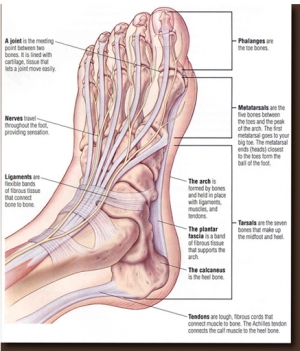Connect With Us
Blogs
Displaying items by tag: Walking
Walk Your Way to Healthier Feet This Year
It’s time for New Year’s resolutions, and at Superior Foot & Ankle Care Center, we know that many of our Douglas Park/Los Angeles County area patients will be thinking about starting new exercise regimens. One of the best and easiest fitness activities you can do is walking.
Some benefits of walking include:
- It’s a great choice if you have been inactive for a period of time.
- Walking has a host of health benefits: improved circulation, helps with weight loss or maintenance, reduces stress, lowers cholesterol, high blood pressure, and high blood sugar, to name a few.
- Walking can be done indoors or out.
- You don’t need expensive equipment—just a good pair of walking shoes.
- It can be done with others or on your own.
- You can take it with you wherever you go.
Getting Started
Before you begin any new fitness program, you should consult your physician. It’s also a good idea to make an appointment at our Long Beach office (call: 562-420-9800) for a podiatric checkup. Our podiatrists, Dr. Victoria M. Foley and Dr. Constance Ornelas will want to do a complete foot and ankle examination. If you have any chronic podiatric conditions such as bunions or plantar fasciitis, the foot doctor will want to evaluate how that condition has progressed and alert you to specific shoe features that will make walking safer and more comfortable. Once you’ve got the green light from your doctors, take the next steps:
- Purchase a pair of good quality shoes designed specifically for walking. Shoes should have a firm heel counter, good arch support, thick, cushioned sole for excellent shock absorption and plenty of room in the toe box. It’s best to go to a sports shoe store and get the assistance of professional. Have your feet measured and let the salesperson know if the podiatrist has told you anything particular about your gait or pronation.
- Make a plan. There are many walking programs available or you can just start on your own. What’s important is that you start off slowly and gradually build up your speed and the duration of your walking. Too much too soon can result in Achilles tendonitis and muscle strains.
- Stay accountable. You may want to enlist a friend to walk with to help you both stay on track. If going it alone, try to commit to a certain number of times a week, and best, if it’s at specific times and days to ensure you stick to your plan. Put walking dates on your calendar.
- Be sure to warm up and stretch before and after your walk. If you experience any pain or discomfort, contact us to get it checked out.
Resolve to Walk in the New Year
If getting in shape is one of your New Year’s resolutions, we at Superior Foot & Ankle Center would like to encourage you to consider walking. Walking is a very effective exercise, particularly if you have been inactive in the recent past. Consider these benefits:
- Can be done all year round outdoors (especially with our beautiful Long Beach weather) or indoors on a treadmill
- Walking is an activity that can be enjoyed alone or with others
- Walking lowers blood pressure, blood sugar and cholesterol while also providing a cardiovascular workout, improved circulation, stress relief and weight loss
- No special equipment is needed (except a good pair of walking shoes)
Of course walking can cause problems as well. Blisters, corns and calluses, plantar fasciitis, shin splints, and Achilles tendonitis are all potential conditions that can occur as a result of walking. You can help prevent these problems from developing, however, by following a few simple tips:
- Make an appointment for a podiatric check up before starting your new walking routine. Our board certified foot and ankle surgeons, Dr. Victoria Foley and Dr. Constance Omelas will examine your toes, feet and ankles and determine if there are any pre-existing problems that need to be treated. The foot doctor can also analyze your gait and see if you tend toward over-pronation, which may affect your shoe choice.
- Choose a sensible walking program that starts out slow and gradually increases distance and intensity.
- Always remember to stretch before and after you walk.
- Invest in good walking shoes and get professionally fitted at a sports or fitness store.
A little soreness or stiffness when you start a new fitness routine is normal but if you find you are experiencing ongoing pain or any swelling or other unusual symptoms contact our Long Beach office by calling: 562-420-9800.
Treating Bone Spurs
How to Treat Bone Spurs
Have you been experiencing a sharp pain in your foot, but you can’t figure out why? Chances are that you have developed a condition called bone spurs.
A bone spur is a small bony growth or a collection of growths which form on joints like the spine, shoulders, hands, hips, knees, and the feet. While we will be focusing on the feet, much of the information below will apply to bone spur treatment in general:
Bone Spurs: Causes
A bone spur occurs when the body attempts to repair itself by building extra bone on areas affected by long periods of pressure, rubbing, or stress.
Bone spurs rarely cause pain on their own. If they grow on the feet, however, calluses may form to cushion the affected area. As the wear and tear on the joints continue, the spurs may compress the surrounding ligaments, tendons, or nerves. This results in injury to the surrounding tissue, in addition to swelling, pain, and tearing.
There are several factors which may contribute to a bone spur. The aging process is partly to blame: cartilage, which covers the ends of bones in a joint, slowly wears away due to a process called osteoarthritis. The damage to the joints will lead to pain and swelling, and will often result in a bone spur. Osteoarthritis is a common cause of bone spurs in joints of the feet and spine.
Tight ligaments will also make you more vulnerable to bone spurs. Many factors can cause this tightness, including strenuous activities which affect the feet like dancing, running, long periods of walking, basketball, and tennis. Other factors include:
- Obesity: excess weight will result in excess pressure on the feet.
- Tight-fitting shoes (like high-heels) can put undue pressure on the feet, causing stress and tightness in the foot, particularly in the heel. Shoes which lack proper arch support, like worn-out shoes, can worsen this problem as well.
- Plantar fasciitis, an inflammation of the plantar fascia ligament. Repeated stretching and tearing of the plantar fascia and other muscles in the feet can lead to increased wear and tear on the heel.
- Abnormalities in walking.
- Diabetes.
- Occupations which require long periods of standing.
- Flat feet or high arches.
Bone Spurs: Treatment
Bone spurs rarely require treatment, unless they cause frequent pain or damage to surrounding tissues. Unless these symptoms are present, it is difficult to detect a bone spur without an X-ray (though it is rare to use an X-ray for this condition, since it rarely causes symptoms). Since heel spurs and plantar fasciitis are closely related, many of the same treatment methods for plantar fasciitis will be used for bone spurs as well. Consider these tips to find relief:
- Resting from the activity causing the bone spur will be recommended. If it cannot be avoided (due to an occupation, for example), ice the affected area immediately after the activity is finished.
- If you have a heel spur, warming up before a strenuous activity and stretching the calf muscles may also be helpful. These stretches will gently lengthen the calf muscle, relaxing the tissue surrounding the heel. Commit to stretching several times throughout the day, particularly in the morning and after a prolonged period of sitting or standing, when the muscles in the feet are stiffest.
- If osteoarthritis or plantar fasciitis are causing pain or damage, weight loss will reduce pressure on the joints and mitigate symptoms.
- Learn how to take proper care of your joints.
- Visit a physical therapist to have an ultrasound or deep tissue massage, especially if your pain is related to plantar fasciitis.
- Wear shoes with good arch and heel support. Try using an orthotic insert in your shoe, to add more support or padding for a corn or callus.
- A doctor may prescribe a corticosteroid injection to reduce pain and inflammation. This will be more of a last resort, since side effects may exacerbate symptoms, especially with heel spurs.
- Discuss surgical removal of the bone spur, which will loosen the plantar fascia.
Consult the Experts
Bone spurs are difficult to detect, and the volume of potential variables related to foot pain can make it difficult to determine the cause. If you’re suffering from foot pain, schedule your consultation with expert podiatrist Dr. Vikki today. Dr. Vikki has a reputed record of patient satisfaction, and is the trusted podiatrist of Special Olympic athletes.
For this and all related foot care concerns, the caring professionals at Superior Foot & Ankle Care Center are happy to help with your podiatric needs.



